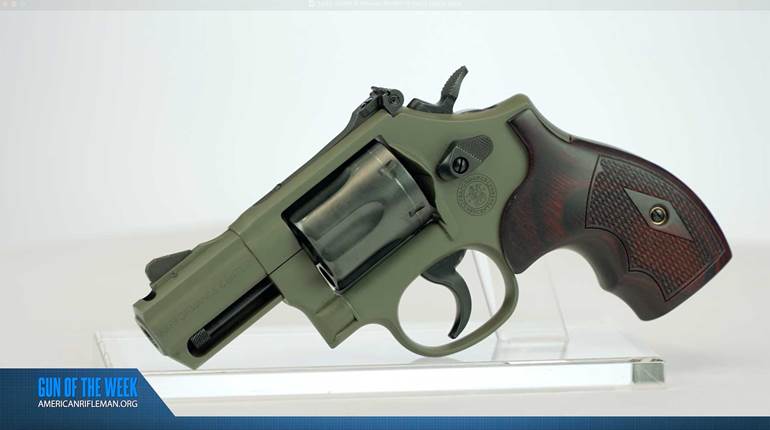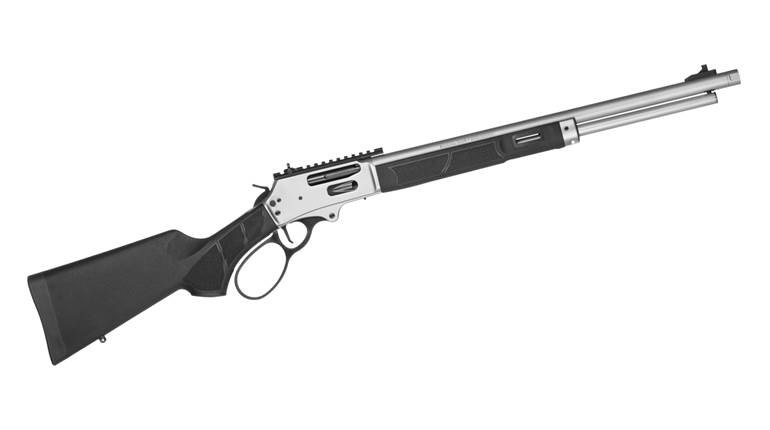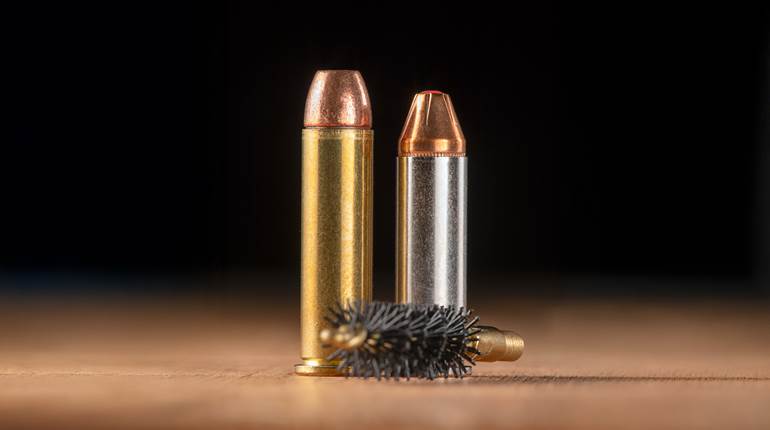
In 1905, the model room at Smith & Wesson’s plant in Springfield, Mass., was astir with activity. The firm had enjoyed 50 years of progress in gunmaking and was determined to go forth in the new century as the leader in handgun development and production. S&W was in the process of modernizing its revolvers to meet the challenges of the day. In the early 1890s, it had developed its first solid-frame revolver with a swing-out cylinder.

Chambered in .32 caliber, these guns were well-received and, a few years later, were joined by an even better series of revolvers in .38 caliber. The firm pressed on with what it knew was necessary for a complete line of modern revolvers: a big bore. In 1907, it offered a modern big-bore revolver and a completely new cartridge to go with it. The cartridge was the legendary .44 Special, and the revolver was the .44 Hand Ejector. Officially dubbed the New Century Model, the gun quickly acquired a nickname that persists to the present day—the Triple Lock.
The first Triple Locks left the factory in 1908 and were immediately accepted as superbly crafted service gun chambered for a great new cartridge. The name comes from a unique feature that was not included on any other S&W before or since. In addition to the pair of locking points with which we are familiar—in the frame at the rear end of the cylinder’s center pin and at the extreme forward end of the pin at a lug on the barrel—the new gun had a third one. The barrel’s underlug had an internal cavity that housed a spring-loaded plunger that locked into a hole in a hardened insert in the swing-out yoke. However, making this system work with the smoothness and precision the company prized was not easy. It required precise hand fitting of parts manufactured to exacting tolerances. Some authorities have asserted that Smith & Wesson devised the system to showcase its skill, and not because there was a mechanical requirement for it.
Perhaps that is true, but the major point of this story is simply that the Triple Lock was the first revolver built on what the factory calls the “N-frame.” Further, this frame is the foundation for a series of modern revolvers that have served the nation’s handgunners, with no small distinction, in peace and war. Virtually all of the company’s many technical and practical innovations were first seen on an N-frame revolver. It is literally the “tree” from which grew the most innovative revolvers of the 20th Century, and it established a solid reputation for quality for the New England gunmaker who planted the seed.

The Triple Lock .44 Spl. guns, called 1st Model .44 Hand Ejectors by collectors, were mostly all made in the new caliber. Although relatively few were made, Triple Locks were also manufactured in .38-40 Win., .44-40 Win. and .45 Colt, as well as a rather large batch of .455s for World War I service with the British military. Within a few years of their introduction, it became apparent to the factory that the third lock was tedious to produce on a mass-production basis. When the British entered World War I, they ordered large quantities of revolvers for their troops. The first 5,000 or so of these guns were .455 Triple Locks, but the mud of the trenches was not kind to that finely fitted mechanism. S&W abandoned it in favor of a barrel shaped much like the tapered round barrel of its Military & Police Model in .38 Spl. The new shape omitted the complex contours of the protective shroud that surrounded the ejector rod. Many more of these models were made for the British, and the factory went forward with the design for its domestic production. Collectors identify this model as the 2nd Model .44 Hand Ejector. Like the 1st Model, it came with 4", 5" and 61⁄2" barrels.
One of the most interesting and historically significant variations of the 2nd Model came to be as a result of America’s entry into World War I. When General Pershing ordered a handgun for every one of his infantrymen, the several factories producing the new M1911 .45 ACP automatic pistols could not meet the demand, but both Colt and S&W had big-bore revolver production lines up and running. Both converted quickly to produce large revolvers chambered for the standard 230-gr. FMJ ammo used in the Colt semi-automatic. It remained for Joe Wesson to come up with the ingenious half-moon clip that adapted the rimless .45 ACP round for use in a revolver. The same basic idea is used today to allow a wide variety of pistol rounds to be used in revolvers. It worked very well, and S&W produced 150,000 Model 1917 .45 ACP revolvers during the war years. With their Ordnance-mandated 51⁄2" barrels and lanyard rings, these rugged revolvers were essentially 2nd Model Hand Ejectors.
"S&W’s Triple Locks are the foundation for a century of progress in revolver making."
When the war was over, S&W continued to produce the 2nd Model .44 Hand Ejector in three barrel lengths and a civilian model variant of the 1917 in 51⁄2" length. Most of the guns were made in .44 Spl. but other calibers such as .44-40 Win. and .45 Colt are known, as are Target Models with a high front sight and adjustable rear sight. In time, however, the factory began to get requests for a barrel shape similar to that of the Triple Lock, even if it did not have the expensive third locking system. When a leading S&W dealer, Wolf and Klar, ordered 3,500 such guns, it was enough to trigger production, and the resulting guns came to be called 3rd Model .44 Hand Ejectors. These rugged, heavy N-frames were produced until World War II. Interestingly enough, they were produced in a separate series from the 2nd Models, which also continued until the 1940-1941 period. In essence, this model came to be synonymous with a heavy, rough, service handgun and was particularly well received in the Southwestern and Western United States.

In the 1920s and 1930s, other forces were at work in society and they were to have a profound effect on the arms industry in general and Smith & Wesson’s products in particular. For one thing, there was a marked rise in armed violence due to the lawless atmosphere surrounding Prohibition and the Great Depression. For another, a number of sportsmen were beginning to use their double-action revolvers as field and hunting arms, a role for which there was no great history. Gradually, a demand evolved for revolvers with greater performance potential, particularly in the sense of penetration. S&W’s initial response was in the form of a .38 Spl. revolver built on the N-frame and called the .38-44 Heavy Duty. At the same time, the ammo makers began to offer special .38-44 ammunition, which was simply .38 Spl. loaded to a higher velocity and not suited for use in lighter guns.
Eventually, the sporting market came to demand better sights and other options on the new beefy .38 Spl. revolver. S&W introduced the Outdoorsman to fill this need, and the gun was very well accepted. Equipped with adjustable target-style sights and available with other features, the Outdoorsman was popular with a growing coterie of handloading handgunners who felt the need for speed. Eventually, such authorities as Phil Sharpe and Elmer Keith used every last bit of space in the .38 Spl. case and cried for more. They got it in 1935, when S&W introduced the spectacular .357 Magnum. The gun itself was built by special order on N-frames, using a special grade of steel in the cylinders. The best fitters in the plant were chosen to put together these revolvers, which were available in any barrel length the buyer specified from 3&1⁄2" to 8". There were many options in sights, hammers, actions and grips. The buyer could get an inscribed certificate of ownership, many of which somehow managed to stay with the gun. To top it all off, each revolver came marked with a registration number neatly stamped inside the yoke cut.
The “Pre-War Registered Magnums” were probably the finest N-frames ever built, and the .357 Mag. cartridge was one of the most influential of all time. S&W heir Col. Douglas Wesson actively promoted the gun with well-publicized hunting trips. Before the Springfield plant halted commercial production to change to World War II work, the demand for the .357 Mag. was so great that it was necessary to drop the gun from special-order status and produce it as a regular catalog item.

During the World War II years, the factory officially produced only K-frame Victory Models, but a trickle of special .357s may have been produced. When the war ended in 1945, S&W was left with worn equipment and excessive bills, but it also hired an energetic Swede named Carl Hellstrom as President. Hellstrom set about modernizing the line with some new models, but also brought back the best of the pre-war guns. It was literally the start of a new era for the fruit of the now-mature Triple Lock tree.
When the plant developed a fancy new short action for the revolver line, collectors referred to it as the .44 Hand Ejector, 4th Model. By 1957, Smith & Wesson returned to the old system of assigning model numbers to its guns. The fixed-sight N-frames in .38 Spl., .44 Spl. and .45 ACP became the Models 20, 21 and 22, respectively. Adjustable-sight N-frames grew in popularity and the .38, .44 and .45 guns came to be called the Models 23, 24 and 25. Actually, there was also a Model 26—a .45 ACP with the classic tapered barrel called the 1950 .45 Target. The immensely popular .357 Mag. was back in a selection of barrel lengths as the Model 27. For the working stiff, S&W offered a plain-Jane, blue-collar .357 Mag. called the Model 28. For a long time, that durable matte blue revolver was the best dollar value in the catalog.
The last in the sequence of N-frame numbers was the gun that defined the post-war N-frame. It was the Model 29, chambered for the new (1956) .44 Magnum cartridge. This round was a logical extension of the reasoning that started with the .357 Mag. In addition to velocity a’plenty, the larger bore of the Model 29 also permitted heavier bullets, usually in the 240- to 250-gr. range. S&W had been barraged with requests for such a gun, many of them coming from a loose confederation of handloading experimenters known as “The .44 Associates.” Elmer Keith had wrestled the absolute most in the way of performance from his beloved .44 Spl. loads and knew there was a need for the .44 Mag. Indeed, the gun was popular when introduced, but went out of sight when Clint Eastwood used it in a famous movie in the early 1970s, after which Models 29s were extremely hard to get for a time.
In 1964, close on the heels of the mighty .44, came another S&W Magnum. It looked the same, but had a smaller bore, measuring an exact .410". The .41 Magnum began as a police service cartridge where it served very well in a few scattered venues. However, despite its limited law enforcement success in a fixed-sight N-frame—the Model 58—the cartridge did a lot better in another big N-frame called the Model 57.

Smith & Wesson’s .41 Mag. still enjoys an almost cult-favorite status among handgunners, particularly those who handload their own ammunition. In 1966, the factory discontinued many of the slow-sellers in the N-frame lineup. This included the fixed-sight guns and such favorites as the Model 24, or 1950 .44 Spl. Target. Anguished cries of protest returned this one classic to the line for a time in the 1980s.
Smith & Wesson had pioneered the use of stainless steel in revolvers with the J-frame Chiefs Special in the 1960s. By the late 1970s, many of the bigger N-frame revolvers became available in the rust-resistant material. Model numbers for these guns include the number “6” in front of the original model number, making a stainless Model 29 a Model 629. Using stainless steel for handguns is only one of S&W’s 20th Century innovations, but it is one that’s here to stay. At the time of this writing, there is only one carbon steel revolver left in the S&W line; everything else is stainless.
Technology had come to the plants where ammunition is developed and produced, but it has had both good and bad effects. In .44 Mag., for example, the use of heavy bullets at higher velocities undoubtedly increased performance, but it also accelerated wear on the N-frame .44s. To keep their products fully competitive, S&W designers came up with an addition to the lockwork—a so-called “bolt block”—that added to the gun’s versatility. In the late 1980s, we began to see a much wider variety of variations of the basic Model 629s, including the Model 629 Classic DX series, with a heavy, full underlug barrel.

Collectors know there are endless variations on all of the basic models. There have been small numbers of N-frames made in such odd calibers as .30 Carbine and .38 Super. Unusual barrel lengths like 5" pre-war Outdoorsman and (possibly) 31⁄2".38-44 Heavy Duty .38s occasionally turn up, and such variants as lightweight alloy N-frames are fully documented. S&W’s Performance Center annually produces a number of unusual N-frames. Currently, the hottest thing going is the scandium alloy N-frames in both .44 Mag. and .45 ACP.
Above all, it’s important to understand that the Smith & Wesson N-frame revolver literally defined the big-bore wheelgun in the 20th century. It had stiff competition from Colt’s fine New Service in the early years, but pretty much dominated in the latter half of the century. For collectors, the variations are endless, but the gun was made for American shooters. And American shooters have been using them in many calibers since the first Triple Locks came out of the old plant in 1908.
*Photos and story by Field Editor Wiley Clapp
This feature has been updated from its original appearance in the March 2005 issue of American Rifleman. To subscribe to the magazine, visit the NRA membership page and select American Rifleman as your member magazine.





































